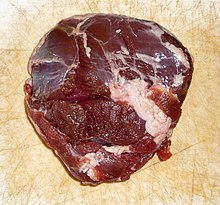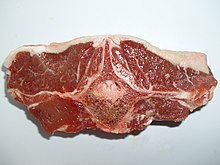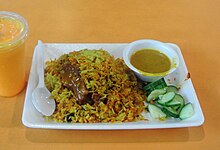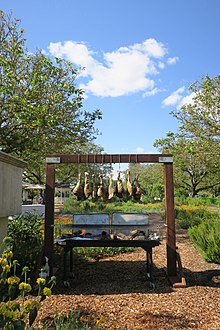Flesh of Mature Sheep Is Called What What Is the Highest Grade of Beef


Lamb, hogget, and mutton, generically sheep meat,[1] are the meat of domestic sheep, Ovis aries. A sheep in its first year is a lamb and its meat is also lamb. The meat from sheep in their second year is hogget. Older sheep meat is mutton. By and large, "hogget" and "sheep meat" are not used by consumers outside Norway, New Zealand, Due south Africa and Australia. Hogget has become more common in England, particularly in the North (Lancashire and Yorkshire) often in clan with rare breed and organic farming.
In South Asian and Caribbean cuisine, "mutton" oft ways caprine animal meat.[two] [three] [four] [five] [6] At various times and places, "mutton" or "goat mutton" has occasionally been used to hateful goat meat.[2]
Lamb is the most expensive of the three types and in recent decades sheep meat is increasingly only retailed as "lamb", sometimes stretching the accepted distinctions given higher up. The stronger-tasting mutton is at present difficult to find in many areas, despite the efforts of the Mutton Renaissance Entrada in the UK. In Australia, the term prime number lamb is ofttimes used to refer to lambs raised for meat.[7] Other languages, for example French, Spanish, Italian and Arabic, make similar or even more detailed distinctions among sheep meats by age and sometimes by sexual activity and diet—for instance, lechazo in Spanish refers to meat from milk-fed (unweaned) lambs.
Classifications and nomenclature [edit]

Lamb chops from a Greek restaurant
The definitions for lamb, hogget and mutton vary considerably betwixt countries. Younger lambs are smaller and more tender. Mutton is meat from a sheep over two years one-time, and has less tender flesh. In general, the darker the colour, the older the animal.
Commonwealth countries [edit]
- Lamb — a young sheep under 12 months of age which does not have any permanent incisor teeth in wear. (From July 1, 2019, the Australian definition is "an ovine animate being that: (a) is nether 12 months of age; or (b) does not have any permanent incisor teeth in clothing."[8] The New Zealand definition also allows "0 incisors in vesture".)
- Hogget — A term for a sheep of either sex having no more than than two permanent incisors in wear,[ix] or its meat. Nevertheless common in farming usage, it is now rare equally a domestic or retail term for the meat. Much of the "lamb" sold in the UK is "hogget" to a farmer in Australia or New Zealand.
- Mutton — the meat of a female (ewe) or castrated male (wether) sheep having more than two permanent incisors in wear.
United states [edit]
In the early 1900s, mutton was widely consumed in the United states, only mutton consumption has declined since World War Two.[ten] As of 2010[update], most sheep meat in the United States comes from animals in betwixt 12 and xiv months old,[eleven] and is called "lamb"; the term "hogget" is non used.[12] Federal statutes and regulations dealing with food labeling in the United states permit all sheep products to exist marketed as "lamb."[13] USDA grades for lamb are just partly a function of the animal'due south age. Animals up to xx months old may meet the quality of the "USDA prime" grade depending on other factors, while "USDA choice" lamb tin can be of any age.[14] "Spring lamb" is defined by the USDA as having been slaughtered between March and Oct.[15]
Indian subcontinent [edit]

The term "mutton" is practical to caprine animal meat in most of these countries, and the goat population has been rising. For example, mutton-curry is always made from goat meat. It is estimated that over ane-third of the goat population is slaughtered every yr and sold as mutton. The domestic sheep population in India and the Indian subcontinent has been in decline for over forty years and has survived at marginal levels in mountainous regions, based on wild-sheep breeds, and mainly for wool product.[ commendation needed ]
Other definitions [edit]
- Milk-fed lamb — meat from an unweaned lamb, typically four–6 weeks old and weighing five.five–8 kg; this is almost unavailable in countries such as the Us and the United kingdom of great britain and northern ireland. The flavour and texture of milk-fed lamb when grilled (such as the tiny lamb chops known every bit chuletillas in Kingdom of spain) or roasted (lechazo asado or cordero lechal asado) is more often than not thought to be finer than that of older lamb, and fetches higher prices.[16] The areas in northern Spain where this tin can exist found include Asturias, Cantabria, Castile and León, and La Rioja. Milk-fed lambs are especially prized for Easter in Greece, when they are roasted on a spit.
- Young lamb — a milk-fed lamb between 6 and eight weeks one-time
- Jump lamb — a milk-fed lamb, usually 3 to five months old, built-in in late wintertime or early on spring and sold usually before 1 July (in the northern hemisphere).
- Sucker lambs — a term used in Commonwealth of australia[17] — includes young milk-fed lambs, as well equally slightly older lambs upwardly to about seven months of age which are too still dependent on their mothers for milk. Carcases from these lambs usually counterbalance between 14 and xxx kg. Older weaned lambs which accept not even so matured to get mutton are known every bit old-season lambs.
- Yearling lamb — a young sheep between 12 and 24 months former, so another term for a hogget.
- Saltbush mutton – a term used in Australia for the meat of mature Merinos which have been allowed to graze on atriplex plants
- Common salt marsh lamb (besides known as 'saltmarsh lamb' or by its French name, agneau de pré-salé) is the meat of sheep which graze on common salt marsh in coastal estuaries that are washed past the tides and support a range of salt-tolerant grasses and herbs, such as samphire, sparta grass, sorrel and bounding main lavander. Depending on where the table salt marsh is located, the nature of the plants may be subtly different. Salt marsh lamb has long been appreciated in French republic and is growing in popularity in the Britain. Places where table salt marsh lamb are reared in the United kingdom of great britain and northern ireland include Harlech and the Gower Peninsula in Wales, the Somerset Levels, Morecambe Bay and the Solway Firth.[18]
- Saltgrass lamb – a type of lamb exclusive to Flinders Island (Tasmania). The pastures on the island have a relatively high salt content, leading to a season and texture similar to saltmarsh lamb.[xix]
Butchery and cookery [edit]
-

Chuletillas of milk-fed lamb in Asturias
-

Lamb shanks of a young lamb
-

The meat of a lamb is taken from the animal between 1 calendar month and one yr erstwhile, with a carcass weight of between five.5 and 30 kg (12 and 66 lb). This meat mostly is more tender than that from older sheep and appears more frequently on tables in some Western countries. Hogget and mutton have a stronger flavour than lamb because they comprise a higher concentration of species-characteristic fat acids and are preferred by some.[twenty] Mutton and hogget also tend to be tougher than lamb (because of connective tissue maturation) and are therefore ameliorate suited to goulash-style cooking, as in Lancashire hotpot, for example.
Lamb is often sorted into 3 kinds of meat: forequarter, loin, and hindquarter. The forequarter includes the neck, shoulder, front legs, and the ribs up to the shoulder blade. The hindquarter includes the rear legs and hip. The loin includes the ribs between the two.
Lamb chops are cutting from the rib, loin, and shoulder areas. The rib chops include a rib bone; the loin chops include only a chine bone. Shoulder chops are commonly considered inferior to loin chops; both kinds of chops are usually grilled. Breast of lamb (baby chops) can exist cooked in an oven.
Leg of lamb is a whole leg; saddle of lamb is the two loins with the hip. Leg and saddle are usually roasted, though the leg is sometimes boiled.
Forequarter meat of sheep, every bit of other mammals, includes more connective tissue than another cuts, and, if non from a immature lamb, is all-time cooked slowly using either a moist method, such as braising or stewing, or past slow roasting or American barbecuing. It is, in some countries, sold already chopped or diced.
Lamb shank definitions vary, but generally include:
- a cutting from the arm of shoulder, containing leg bone and part of circular shoulder bone, and covered by a thin layer of fatty and fell (a thin, paper-similar roofing).
- a cutting from the upper part of the leg.
Mutton barbeque is a tradition in Western Kentucky. The area was potent in the wool trade, which gave them enough of older sheep that needed to exist put to use.[21]
Thin strips of fatty mutton tin can be cut into a substitute for salary called macon.
Lamb tongue is popular in Eye Eastern cuisine both equally a common cold cut and in preparations like stews.[22]
Cuts [edit]
United kingdom, Canada, and other Commonwealth countries [edit]

Approximate zones of the usual UK cuts of lamb:[23]
- Scrag finish (of cervix)
- Centre neck
- Best End (of neck)
- Loin
- Chump (and doormat chops)
- Leg (gigot in Scotland)
- Shank
- Shoulder
- Chest
U.s. and Ireland [edit]
- Square cutting shoulder – shoulder roast, shoulder chops and arm chops
- Rack – rib chops and riblets, rib roast
- Loin – loin chops or roast
- Leg – sirloin chops, leg roast (leg of lamb)
- Neck
- Chest
- Shanks (fore or hind)
- Flank
New Zealand [edit]
[24] [25]
- Forequarter
- Cervix – neck chops
- Shoulder – shoulder chops, shoulder roast (commonly boned and rolled)
- Rib-center
- Breast
- Shank
- Loin
- Rib-loin – racks, frenched cutlets, spare ribs
- Mid-loin – striploin (backstrap), loin chops
- Tenderloin
- Flap
- Full leg – leg roast (may exist boned and rolled), leg chops. A brusk-cut leg is a full leg without the chump; a carvery leg is a short-cutting leg without the thick flank
- Chump (rump) – chump chops, rump steak
- Thick flank (knuckle) – schnitzel
- Topside & silverside – steaks
- Shank
Production and consumption figures [edit]
Sheep meat consumption [edit]
According to the OECD-FAO Agronomical Outlook for 2016, the tiptop consumers of sheep meat in 2015 were as follows:[26] Eu countries are not individually surveyed in this list. Amidst European union nations, Hellenic republic is the per capita leader in consumption at 12.3 kg,[27] while the UK's annual per capita lamb consumption is 4.7 kg.[28] Outside of the OECD, the largest per capita consumer overall is Mongolia, with 45.1 kg.[28]
-
 Serbia – 10.five kilograms (23 lb) per capita
Serbia – 10.five kilograms (23 lb) per capita -
 Kazakhstan – 8.ane kilograms (xviii lb)
Kazakhstan – 8.ane kilograms (xviii lb) -
 Commonwealth of australia – 7.four kilograms (sixteen lb)
Commonwealth of australia – 7.four kilograms (sixteen lb) -
 Algeria – 7.ane kilograms (16 lb)
Algeria – 7.ane kilograms (16 lb) -
 Uruguay – v.vii kilograms (13 lb)
Uruguay – v.vii kilograms (13 lb) -
 Saudi Arabia – 5.5 kilograms (12 lb)
Saudi Arabia – 5.5 kilograms (12 lb) -
 New Zealand – 4.four kilograms (9.7 lb)
New Zealand – 4.four kilograms (9.7 lb) -
 Turkey – iv.i kilograms (9.0 lb)
Turkey – iv.i kilograms (9.0 lb) -
 Iran – three.2 kilograms (seven.1 lb)
Iran – three.2 kilograms (seven.1 lb) -
 Southward Africa – iii.ane kilograms (half dozen.viii lb)
Southward Africa – iii.ane kilograms (half dozen.viii lb)
Sheep meat production [edit]
The tabular array below gives a sample of producing nations, but many other significant producers in the fifty–120 KT range are not given.
| 2008 | 2009 | 2010 | 2011 | 2012 | |
|---|---|---|---|---|---|
| World | viii,415 | 8,354 | eight,229 | 8,348 | 8,470 |
| | 179 | 197 | 205 | 253 | 261 |
| | 660 | 635 | 556 | 513 | 556 |
| | 79 | 80 | 82 | 84 | 85 |
| | 1,978 | 2,044 | 2,070 | 2,050 | two,080 |
| | 130 | 126 | 119 | 115 | 114 |
| | 38 | 38 | 38 | 39 | 36 |
| | 91 | 90 | 90 | 90 | 90 |
| | 275 | 286 | 289 | 293 | 296 |
| | 113 | 128 | 113 | 113 | 113 |
| | 170 | 114 | 90 | 104 | 126 |
| | 110 | 116 | 123 | 128 | 128 |
| | 598 | 478 | 471 | 465 | 448 |
| | 145 | 149 | 171 | 172 | 174 |
| | 156 | 164 | 167 | 171 | 173 |
| | 278 | 262 | 240 | 253 | 272 |
| | 124 | 128 | 130 | 130 | 133 |
| | 326 | 307 | 277 | 289 | 275 |
| | 81 | fourscore | 76 | 69 | 72 |
Source: Helgi Library,[29] Earth Banking company, FAOSTAT
Dishes [edit]


Lamb (in front) existence roasted on a roasting spit in Novalja, island of Pag, Croatia.
Meat from sheep features prominently in the cuisines of several Mediterranean cultures including Greece, Croatia, Turkey, North Africa, Jordan, and the Middle East, likewise as in the cuisines of Islamic republic of pakistan and Afghanistan. In Greece for example, it is an integral component of many meals and of religious feasts such equally Easter (run into avgolemono, magiritsa). Information technology is also very popular in the Basque culture, both in the Basque state of Europe and in the shepherding areas of the Western U.s.a.. In the Usa, the Navajo have incorporated mutton and lamb into their traditional cuisine since the introduction of sheep by Spanish explorers and settlers in the 17th century, replacing wild turkey and venison and creating a pastoral culture. In Northern Europe, mutton and lamb feature in many traditional dishes, including those of Iceland, Norway and of the United Kingdom, particularly in the western and northern uplands, Scotland and Wales. Mutton used to be an of import part of Hungarian cuisine due to potent pastoral traditions but began to be increasingly looked downwardly on with the spread of urbanisation.[ commendation needed ]
Mutton is also popular in Australia. Lamb and mutton are very popular in Fundamental Asia and in certain parts of China, where other red meats may exist eschewed for religious or economic reasons. Barbecued mutton is besides a specialty in some areas of the United States (chiefly Owensboro, Kentucky) and Canada. However, meat from sheep is more often than not consumed far less in the US than in many European, Central American and Asian cuisines; for example, average per-capita consumption of lamb in the United States is but 400 grams (fourteen oz) per yr.[28]
In Commonwealth of australia, the leg of lamb roast is considered to be the national dish.[xxx] Commonly served on a Sunday or whatsoever other special occasion, it tin exist done in a kettle BBQ or a conventional oven. Typical training involves covering the leg of lamb with butter, pushing rosemary sprigs into incisions cut in the leg, and sprinkling rosemary leaves on top. The lamb is then roasted for two hours at 180 °C (350 °F) and typically served with carrots and spud (also roasted), green vegetables and gravy.
In Indonesia, lamb is popularly served equally lamb satay[31] and lamb curry.[32] Both dishes are cooked with diverse spices from the islands, and served with either rice or lontong. A version of lamb and bamboo shoot curry is the specialty of Minang cuisine, although similar dish could also be establish in Thai cuisine.
In Mexico, lamb is the meat of choice for the pop barbacoa dish, in which the lamb is roasted or steamed wrapped in maguey leaves underground.[ citation needed ]
In Medieval Republic of india, the armies, unable to cook elaborate meals, would gear up a one-pot dish where they cooked rice with mutton. This dish led to the famous Biryani.
In Japan, although lamb is not traditionally consumed in most of the state, on the Northern island of Hokkaido and North-eastern Tohoku regions, a hot pot dish called Jingisukan (i.e. "Genghis Khan") is popular. In that dish, thin-sliced lamb is cooked over a convex skillet alongside various vegetables and mushrooms in front of the diners, then dipped in soy-sauce based dipping sauces and eaten. Information technology was so named considering lamb is popular in Mongolia (see "Sheep meat consumption" above).
Organ meats / Offal [edit]
Lamb's liver, known as lamb'southward fry in New Zealand and Australia,[33] is eaten in many countries. It is the most common class of offal eaten in the UK, traditionally used in the family unit favourite (and pub grub staple) of liver with onions and/or bacon and mashed potatoes. Information technology is a major ingredient, forth with the lungs and centre (the pluck), in the traditional Scottish dish of haggis.
Lamb testicles or lamb fries are a delicacy in many parts of the globe.
Lamb kidneys are found in many cuisines across Europe and the Eye East, often carve up into 2 halves and grilled (on kebabs in the Middle East), or sautéed in a sauce. They are generally the most highly regarded of all kidneys.
Lamb sweetbreads are a effeminateness in many cuisines.[34]
Ecology impact [edit]

The amount of agricultural state needed globally would be reduced by virtually half if no beef or mutton were eaten.
| Food Types | Land Utilize (m2twelvemonth per 100g protein) |
|---|---|
| Lamb and Mutton | 185 |
| Beef | 164 |
| Cheese | 41 |
| Pork | 11 |
| Poultry | 7.1 |
| Eggs | 5.seven |
| Farmed Fish | 3.7 |
| Groundnuts | 3.5 |
| Peas | 3.iv |
| Tofu | 2.two |
Production of lamb emits more greenhouse gas per gram of protein than other mutual foods, except for beefiness.[36]
See also [edit]
- Lechazo de Castilla y León – milk-fed lamb meat from Espana
- List of lamb dishes
- Mutton curry
- Mutton flaps
- Goat meat
- Sheep's trotters
- Smalahove – a Western Norwegian dish of sheep head
Bibliography [edit]
- One thousand.F. Warner, "Boning Lamb Cuts", Leaflet 74, U.S. Department of Agriculture, Bureau of Fauna Manufacture, June 1931. full text
- Bob Kennard, "Much ado about mutton". Ludlow: Merlin Unwin, 2014 [37]
Notes [edit]
- ^ Oxford English language Dictionary Third edition, Baronial 2010; online version November 2010
- ^ a b Oxford English Dictionary, 3rd edition, June 2003, [https://www.oed.com/view/Entry/124371 southward.v., definition 1b
- ^ "Whose goat is it anyway?". Hindustan Times. 11 February 2012. Retrieved 15 May 2015.
- ^ Charmaine O'Brien, The Penguin Food Guide to Republic of india, section "The Commons", under "Mutton", ISBN 9780143414568
- ^ Madhur Jaffrey, An Invitation to Indian Cooking, ISBN 0375712119, p. 49
- ^ Janet Groene, Gordon Groene, U.S. Caribbean Guide, 1998, ISBN 1883323878 p. 81
- ^ Australian Prime Lamb Industry, 2000 Archived xiii Apr 2011 at the Wayback Machine
- ^ "Australia'southward New Definition of Lamb – What You Demand to Know" (4 July 2019). SheepProducers.com.au. Retrieved 28 September 2019.
- ^ Delbridge, Arthur, "The Macquarie Dictionary", 2nd ed., Macquarie Library, N Ryde, 1991
- ^ Fogarty, Lisa (26 November 2019). "After WW2 mutton barbarous out of favor in the U.S." NPR . Retrieved 17 March 2020.
- ^ "Lamb Sector at a Glance". United States Department of Agriculture . Retrieved 17 March 2020.
- ^ Merriam-Webster Lexicon, south.v. hogget: "chiefly British"
- ^ 7 CFR 65.190
- ^ "Yearling Lamb" (PDF). United states of america Section of Agriculture . Retrieved 17 March 2020.
- ^ "Lamb from farm to tabular array". U.s.a. Department of Agronomics . Retrieved 17 March 2020.
- ^ "Speleogroup – sg2012". speleogroup.org.
- ^ "Australian Sheep CRC". sheepcrc.org.au.
- ^ Keating, Sheila."Food Detective: Salt Marsh Lamb." The Times Online, 28 June 2008.
- ^ Bastick, C. H. and Walker, 1000. G, Extent and impacts of Dryland Salinity in Tasmania. "[1]" Department of Primary Industries, Water and Environment, August 2000.
- ^ Fearnley-Whittingstall, Hugh. "What Is Mutton – Understanding the History Archived 23 July 2017 at the Wayback Machine." Mutton Renaissance.
- ^ "Owensboro Kentucky Mutton Barbecue".
- ^ "Lebanese Recipes, Lamb Tongue Salad, oregano, pepper, salt ginger". discoverlebanon.com.
- ^ Montagné, Prosper (2001). Larousse Gastronomique. Third Edition. Éditions Larousse: French republic. ISBN 0-600-60235-4
- ^ "Beef + Lamb New Zealand Reference Guide" (PDF) . Retrieved ten June 2021.
{{cite web}}: CS1 maint: url-status (link) - ^ Nicol, Alistair; Saunders, Caroline (24 November 2008). "Lamb cuts". teara.govt.nz . Retrieved ten June 2021.
{{cite web}}: CS1 maint: url-status (link) - ^ Meat consumption, OECD Data. Retrieved 25 October 2016.
- ^ "2018 Red Meat Market Snapshot" (PDF). Meat and Livestock Commonwealth of australia . Retrieved 17 December 2018.
- ^ a b c "Is the UK unusually addicted of lamb and potatoes?". BBC News. 2 September 2014.
- ^ "HelgiLibrary - Sheep Meat Production". helgilibrary.com.
- ^ "Roast lamb rules as Australia's national dish". 2 February 2010.
- ^ Owen, Sri (1999). Indonesian Regional Nutrient and Cookery Past Sri Owen. ISBN9780711212732 . Retrieved 7 July 2010.
- ^ Susilowati Primo (21 March 2013). "Lamb curry (gulai kambing)". Food.
- ^ Delbridge, Arthur, The Macquarie Dictionary, 2nd ed., Macquarie Library, North Ryde, 1991
- ^
- Sweetbread recipes BBC food
- "Sweetbreads", British Food: A History
- ^ Nemecek, T.; Poore, J. (1 June 2018). "Reducing nutrient's ecology impacts through producers and consumers". Science. 360 (6392): 987–992. Bibcode:2018Sci...360..987P. doi:10.1126/science.aaq0216. ISSN 0036-8075. PMID 29853680.
- ^ "Interactive: What is the climate touch of eating meat and dairy?". url . Retrieved 5 June 2021.
{{cite web}}: CS1 maint: url-status (link) - ^ "Much Ado About Mutton". www.merlinunwin.co.uk.
External links [edit]
- Sheep Meat Production
Source: https://en.wikipedia.org/wiki/Lamb_and_mutton
0 Response to "Flesh of Mature Sheep Is Called What What Is the Highest Grade of Beef"
Enregistrer un commentaire